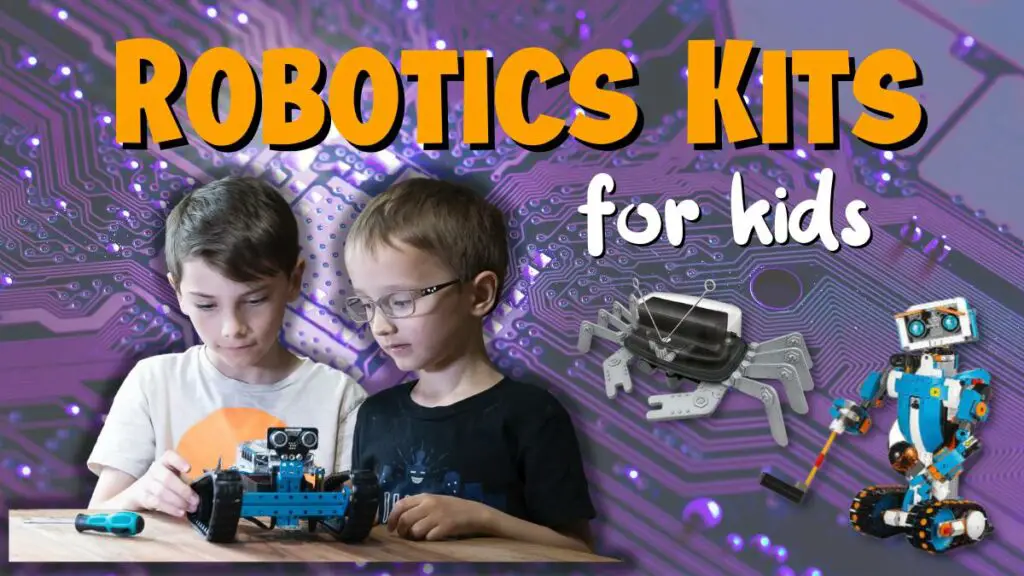STEM activity kits have the primary goal of helping children learn more advanced concepts and establish curiosity that you can nurture in the future.
When you are looking to buy a STEM activity kit, some of the essential things to remember are the age, the type of content, the price, the kind of learning, and the safety precautions. These five aspects are essential to the happiness and progress of the participant, so do research before buying.
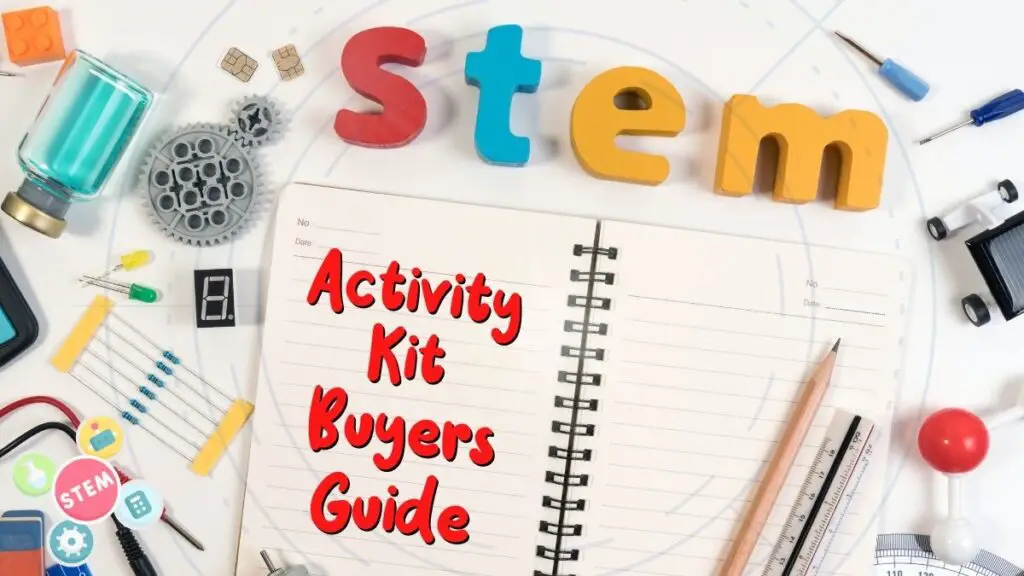
*We’re an affiliate – we may earn a commission through qualifying purchases from the links on this page. As always, thanks!*
STEM kits can help anyone, young and older, focus their mind and sharpen their skills if used right. However, since there are so many diverse kinds on the market, it can be tricky to know which one will be the best. For this reason, I have made a list of the things you need to look for before making your decision.
What To Look For When Purchasing A STEM Activity Kit
Below is a list of the fundamental aspects you need to look for before buying a STEM kit. Some of these things might seem logical, but you can never be too safe.
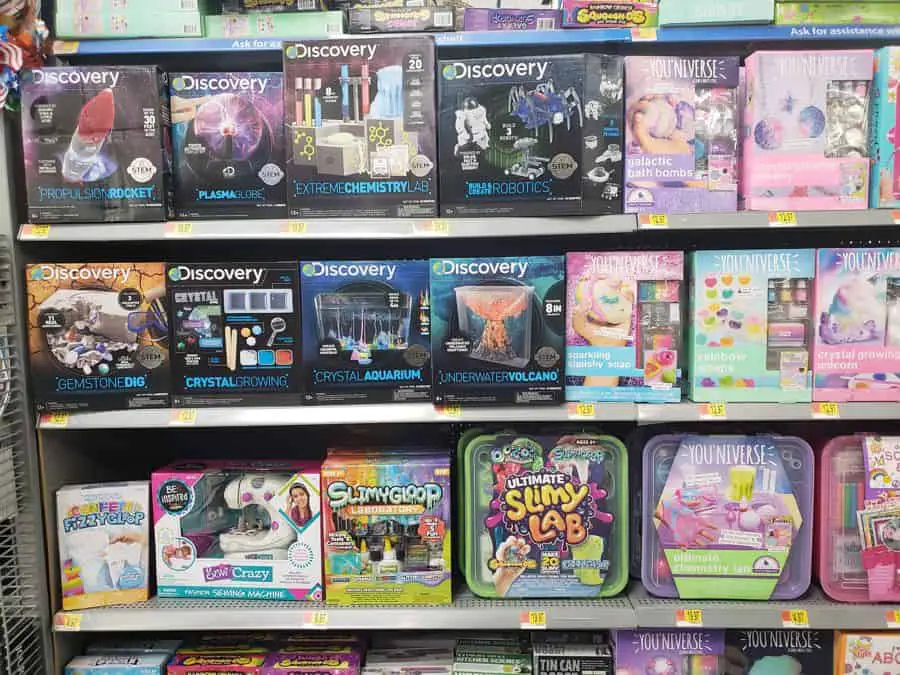
Match the Age of the Kid with the Age of the STEM Kit
STEM kits usually aim to pique the interest of younger kids, a few seek to help adults. Most of the assortments on the market have a minimum age for a guideline but not a maximum age.
You’ll find it’s a balancing act. The age recommendations on the STEM kits help you save money by preventing boredom or loss of interest in your chosen kit.
Though you would think that it is a good thing to offer more advanced kits to younger children in the hope of nurturing curiosity and advancing their skills from an early age, it is likely to do the opposite. I can tell you first hand there is some disappointment in getting a cool STEM set that’s a bit ‘older’ than suggested for your kid. We’ve had more than one kit our son opened and within a few minutes deemed it “too hard” and dismissed it.
So, a young kid interested in robots may not quite know what to do with a STEM project with a Raspberry Pi or Arduino, though these may be perfect for a tween or teen.
On the other hand, you can purchase a kit that offers too little challenge and intrigue for someone in a higher age bracket. When working with a kit that’s perfect for our 5 year old, our 7 year old will sometimes lose interest (unless there’s a volcano or catapult involved – those are always a sure bet.)
Still, there is the chance of learning something from a STEM kit made for a younger age if the kit touches on a field that the participant shows interest in but has not explored before.
Either way, the age on the kit is there to help you make the right choice and prevent you from wasting your money. If you wish to look for a STEM kit for your child, it is best to buy an activity set within their age range and is something they have at least a casual interest in.
STEM Kit for younger kids: SNAEN Science Kit with 30 Science Lab Experiments
STEM kit for older kids: Engino Discovering STEM Fluid Dynamics (or other Engino Kits)
Find the Right Themed STEM Kit
STEM kits can try to be a bit of everything, or just focus on one element (usually an aspect of Science, Technology, Engineering; Math doesn’t seem to get much love in the kit department.)
STEM kits have a better chance of being a hit if the activities related to a subject or interest to the intended participant(s). Though these activity sets help broaden the horizons, you have to be very careful not to spend money on a kit that is a bit off target.
If your child gravitates towards a specific field, nurture that interest by buying a STEM kit relevant to that field of interest. If your child is interested in robotics, buying them a set about geology might keep them occupied and teach them something, but it may not be as well received as something that speaks to their passion.
If you’re trying out a kit to explore or don’t know quite what to buy, you can try a STEM subscription box. These are curated sets that come delivered to your doorstep with everything needed for the experiments and activities. Each month usually provides a kit with a different theme so, if one doesn’t resonate, next month’s kit will be something different. Subscription boxes can make the perfect gift, especially if you’re not sure what to get.
If you’re still unsure, go with a kit that provides a range of experiments. Our kids were gifted this Science Kit set, and loved it. Mind you, every experiment wasn’t a hit, though there were enough of the things we did out of this kit they enjoyed to provide value and entertainment.
If you are looking to buy a STEM kit for yourself, you’re sure to buy something you’re interested in. Just don’t expect your kids to always be as enthusiastic as you are. And (ahem), take it from someone who knows, buying a STEM kit you’re interested in “for the kids” may not always be a great fit. But at least you get to play with it.
Teaching Techniques for Activity Kits
There are two main teaching techniques when it comes to STEM activity boxes. The first of these techniques is the guided learning system. This type of learning will guide the participant through a journey of exploring the box’s contents and usually provides activities and a step by step process. (Think of a Lego kit with detailed step by step instructions and diagrams. Yes – Lego makes a great STEM toy!)
The other method is a blank canvas, which means the participant has complete freedom and minimal guidance. (Think of getting a bucket of Lego bricks.)
When considering the teaching techniques of a STEM kit, consider this in conjunction with age and content. The age and content will have an enormous impact on how effective the teaching style will be. For example, a science set for kindergartners without clear and detailed instructions is a recipe for disaster.
In the same breath, you also do not want to receive such strict instructions that there is no place for exploring. Half of the fun of a STEM kit comes from doing some things yourself or applying what you’ve learned differently. It is essential that you consider the techniques of the STEM kit and maybe read some in-depth reviews before making the purchase.
The Safety Of The Kit
Though most of the STEM kits you can buy will be safe for use under most circumstances, there are some times when you need to practice extra caution to ensure that everyone is safe. When working with electricity, chemicals, or machines, you should be sure that you and your loved ones stay safe.
Furthermore, if you buy a STEM kit for one of your children or a younger person, there is the possibility that they could get hurt or even put something dangerous in their mouth. For this reason, always keep an eye on any little ones using one of these sets. If you’re giving a kit to a toddler or kindergartner (or if they’re playing along), assume they will immediately put anything presented to them in their tiny gaping maw.
While I can get our kids to do anything where something pops, bangs, booms, or flies across the room, remember – Safety First.
The Price Of The STEM Kit
Sometimes it just comes down to the bottom line. The price of a STEM kit and your budget can help determine what you’re looking for. There are both cheaper and more expensive STEM kits, with some more intricate ones, like coding kits, costing a lot more. However, some kits will be more expensive based on their contents, but naturally, the name of the manufacturing brand can also affect the price (I’m looking at you, Lego Mindstorms.)
It is essential to read up on a specific kit before buying it. Reading reviews and finding out about the price compared to the quality might take some time but will help you in the long run. Buying a STEM toy at the dollar store may be cheap, but not provide the best value.
Don’t be discouraged by price though. There are some modestly priced kits that maintain quality and kids love.
That said, if you are looking to buy a kit that includes mechanical components or coding things, I recommend not skimping on the price if you find a set that guarantees the quality of their products.
Awesome Expensive Kit: Lego Mindstorms
Fun Budget Kit: Science Kit set
How To Choose The Right STEM Kit
Though the aspects above will help you pick a suitable STEM kit for anyone, I’d like to give you a bit more insight. Below are some tips to help you choose something for different age groups.
Buying The Right STEM Set For A Kindergartner
Since kindergartners are between the ages of 5 and 6, you will need to ensure that you buy a safe STEM kit for little ones to use. Moreover, you will also need to ensure that it is attractive to children of this age. Hands on activities are a sure bet for this age group.
At this age,you’re going to find targeted STEM activities rather than a complete STEM kit. For example, this Magnet Movers set for ages 5+ has a few magnet activities (and quite a few small pieces) and this space kit is targeted for younger kids. An entry level microscope may be just the thing for a budding scientist (or curious kid.)
Think Outside has some nature themed subscription box “junior” series for kids ages 4-7. Little Passports has an “early explorers” series for kids 3-5.
You might also want to check out some STEM toys, which are toys that target specific STEM skills. Check out our post on STEM toys 5 year olds and 6 year olds for some ideas.
Our son enjoyed making and growing this glow in the dark terrarium kit aimed at kids 5-8.
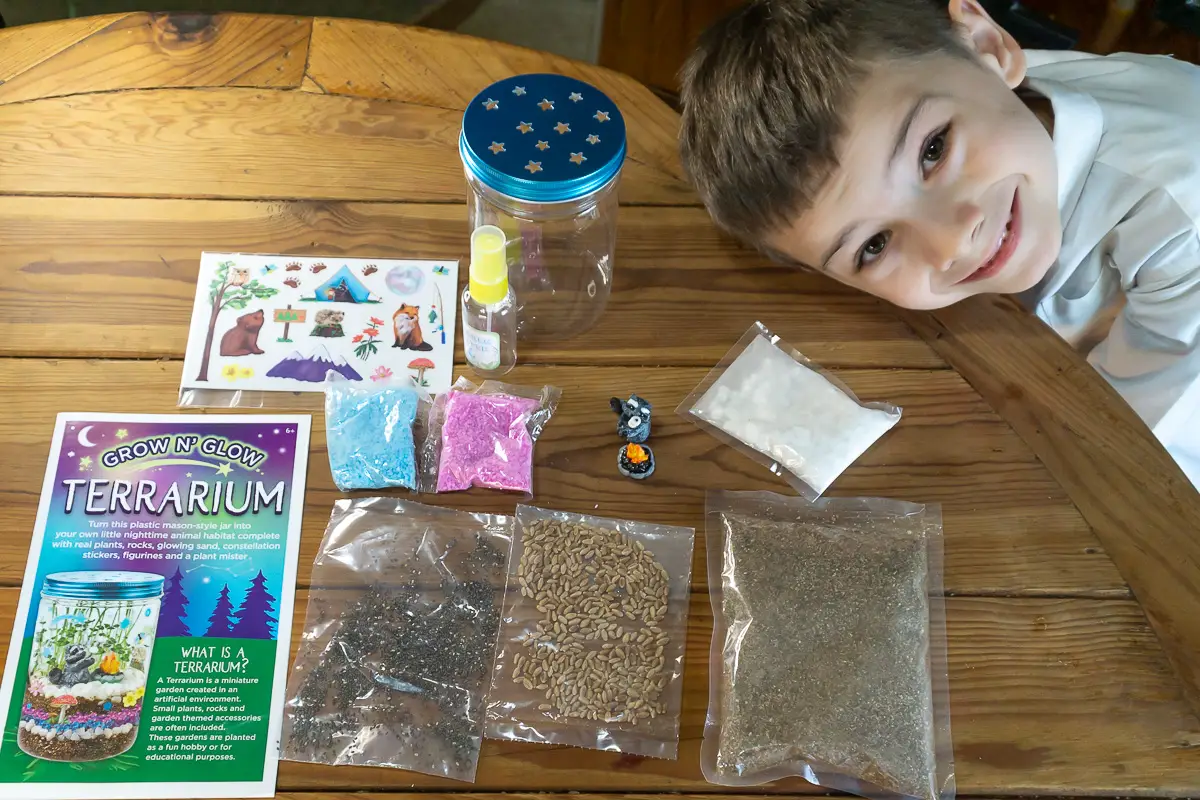
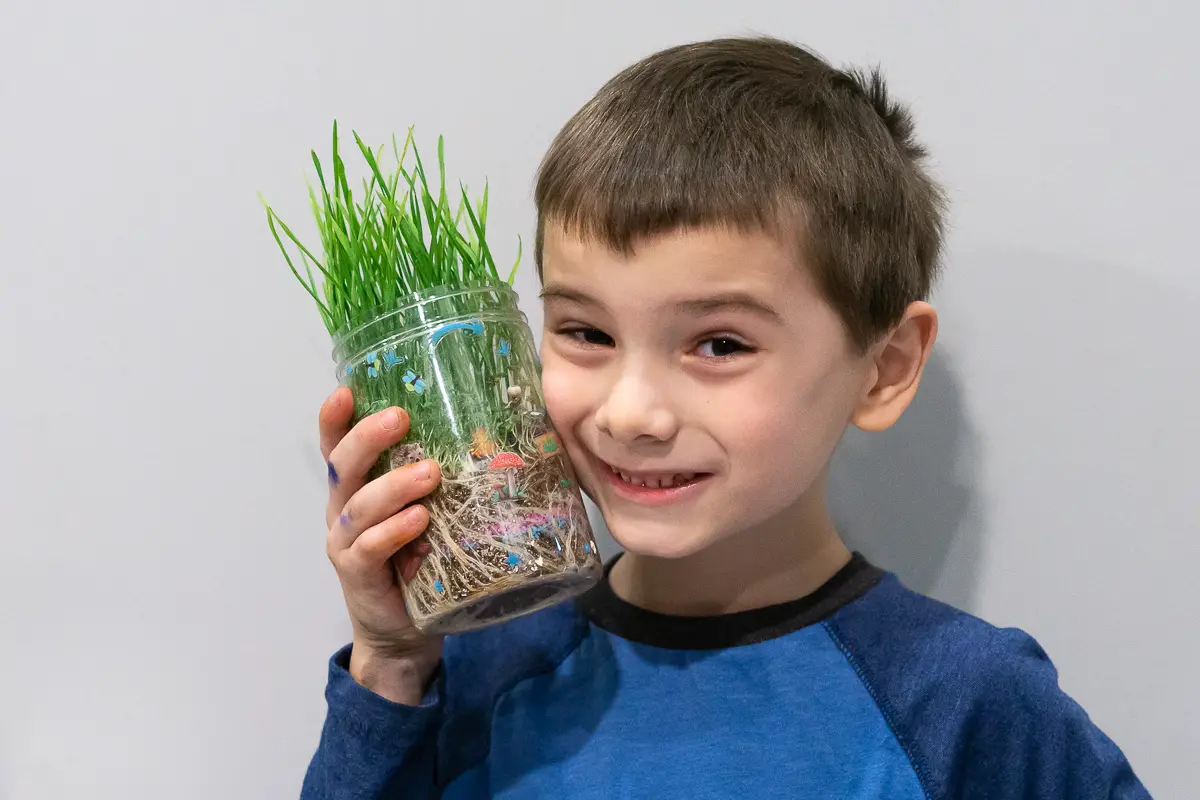
One of the most common STEM toys for young children is building blocks. For very young children, stick to larger blocks and avoid choking hazards. You can’t go wrong with a classic wooden block set. We always love Legos, though kids at this age would do better with Mega Bloks or Duplos if you’re looking to get them some building toys. Check our post on Building Toys for some ideas and inspiration.
Buying the Right STEM Set For A Elementary-Schooler
For children between 7 and 10, buying a STEM kit can be simple yet challenging in the elementary school stage. Beyond selecting a kit that meets the child’s interest, attention span (which is usually relatively short), will be the main challenge here. I can’t count the number of projects I’ve started with the kids and found I was doing by myself a few minutes later.
The best advice to follow when buying a STEM kit for this age group is to find a set that relates to their interests. There is likely at least one field the child is interested in or has spoken to you about at this age. Be sure to take note of the fields a child is interested in at this stage.
There are plenty of STEM kits for kids at this age, including some games. You can find some classic Chemistry Kits targeted for this age group. Our kids enjoyed the experiments in this set from SNAEN Science with materials and directions for 30 different projects.
Squishy Circuits combines the tactile experience of Playdough with basic electronics. An entry level Snap Circuits kit is also worth checking out. It’s something they can build on with more advanced kits as they (and their ability level) grow.
The top category of STEM kits for kids that this age is coding. (Check out our post on coding toys for some ideas.) Since coding is a skill that is good to have, you can teach your child how to code robots, toys, and even Lego machines using a variety of STEM kits. For this age range check out the Klutz Gear Bots or Boost sets.
Our kids liked playing with this Coding and Robotics kit and controlling to steps and movements for the robots. Our 5 year old got a motor skills workout putting the pieces together, and our 7 year old was learning some block programming basics.
For a subscription box with coding projects for Kids 6-12, check out BitsBox. Groovy Lab in a Box also has some great kits for ages 8 and up.
Things To Consider For A Middle-Schooler STEM kit
Children in middle school are usually between 11 and 13 years of age, meaning that they can be very bright already. However, you can still buy the STEM kits to help them learn more or faster and expand their knowledge base.
This is a great age range where many STEM kits are targeted, so there is a huge selection. At this age, I highly suggest getting your child a more advanced STEM kit to stimulate their minds while they learn. Naturally, it is still essential that you know what your child is interested in, but you can also provide STEM kits to encourage other skill development at this age.
This Mars exploration themed kit teaches environmental science topics like ecology, composting, and sustainable food. It hits the right notes for kids interested in space, environmentalism, or plants.
Some of the best STEM kit categories for this age include robotics sets, coding and programming sets, and computer kits. It might be good to start early with skills like these (as long as your child is interested in the subjects.) Some STEM kits will promote more complex concepts or skills that may be useful heading into high school. That said, you don’t want to buy a kit they’re not interested in or have them feel forced into any specific direction.
Creation Crate has some interesting STEM kits for ages 12 and up.
Things To Consider For A High-Schooler STEM Kit
Just because your child is going to high school does not mean learning happens only in the classroom. Some exceptional skills can be taught through STEM activities or kits. At the age between 14 and 18, all the skills you learn are beneficial for your future. If your child decides what direction to study or work in, this is always a safe bet if you want to help and buy them a STEM kit.
STEM kits for high school age kids are less like toys and more “grown up.” This chemistry set provides a wide range of materials and experiments.
This is also where more advanced kits like Raspberry Pi and Arduino come in. These are basically self contained, programmable computers on a single board. Check out this highly articulated spider-like robot that self balances and has a camera with facial recognition or this robot dog that looks similar to the ones developed by Boston Dynamics.
Some of the more advanced sets also come with a more advanced price tag. Before dropping serious money on a kit, make sure it’s a good fit. The safest way to go for this age is to ask your child to choose one themselves. Speak to them and explain that you want to help them achieve their goals dreams and that a STEM kit might help them get a head start.
Things To Consider finding a STEM kit for an Adult
After school, it is more likely that you will be buying yourself a STEM kit rather than someone buying one for you. Though it might seem strange to buy a STEM kit at an age above 18, there are still some uses for something like this. The same guidelines apply if you’re gifting someone a STEM kit – make sure it’s age appropriate and of interest tot he recipient.
It’s common for people to change careers multiple times, and STEM kits could help you rediscover your interests and can help you form a fundamental understanding before studying to take a new job. Naturally, you may not want to buy a set meant for a 4-year-old, but don’t be afraid to start slow if you’re exploring an entirely new topic.
Remember, not everything has to be “for the kids.” It’s okay to buy STEM Kits – even toys – for yourself. And maybe the kids will still want to play with you.
Check out our post on robotics kits for kids for more STEM Kits!
Wrap Up – STEM Activity Kits
There are tons of different kits for nearly any type of person. You can find science projects, robot kits, kits that focus on a specific topic (like Earth Science or Ecology), or combine STEM and art projects.
The skills kids learn through the help of STEM kits at this age could potentially shape the future they choose. If you can set a solid foundation, you can help your child become independent and significantly improve their school performance. Looking a little further ahead, skills like coding, programming, and computer skills are beneficial for securing a job.
We often look to STEM to develop critical thinking skills or help with creative thinking. Remember STEM kits should also be fun! Matching age and interests will be key to selecting a kit.
Finding a suitable set isn’t hard if you know the person’s interests you’re buying for. Always check the kit’s required age and the participant’s age to ensure that you will not be harming the child or boring them and wasting money. STEM kits and activities can help you shape the mind of both children and adults while providing hours of fun.


